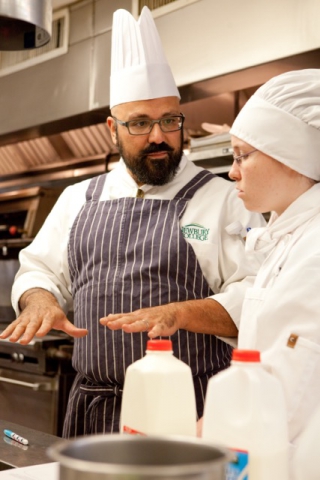
Smell Hunting: Teaching Why the Bakery Smells Good
31 October 2018Training students’ olfactory experiences by creating smell maps of city areas with smell catching and hunting.
By David Pazmino, Chef instructor
Feedback & comments: This email address is being protected from spambots. You need JavaScript enabled to view it.
We have it lucky in the bakery. People gravitate toward the smell of baked goods like flies to honey. That Pavlovian response to the smell of baked goods is strong, but for many students it is hard for them to explain why. Training a student to discern smells rather than simply using monikers like that smells “good” or that smells “bad” means giving them both the experience and language to express their olfactory experiences into words.
In my article, Sniff, Sniff Like a Dog I referenced a wine instructor who constantly used that phrase during wine seminars. While humans only have about 20 million smell receptors, dogs have about 200 million receptors. Even though our ability to detect the full range of smell is limited, it can be trained. One of my colleagues introduced me to Kate McLean, who creates sensory smelling maps of urban New York. She runs “smellfie” tours where she guides people by smells through the streets of New York, giving participants a different way to walk through the city. While we often walk around using our eyes as our primary way of analyzing the environment, we often neglect to use our nose as a means of defining our movements.
But what does this all have to do with culinary students? Learning the language to express what students smell is another key part of their professional training. I remember as a young culinarian working in kitchens and having chefs with the keen sense of smell who were able to tell when something was cooked by smell alone. Kitchens were often spaces that had all sorts of good and bad smells but I had not yet developed the ability to distinguish individually. Through time, every great cook develops this heightened sense of smell -- for some it happens innately while others need more concrete tools.
Taking cues from Kate McLean and her work developing smell maps, I have taken students on field trips into Boston. (While this is a fairly urban area, this same technique could be easily replicated in other environments.) There are two main principles to creating these smell maps: smell catching and smell hunting. The principle behind the first is that you record the passive smells you get by walking along the streets. My first choice in Boston is always Chinatown. Here, there are so many unique and intense smells. It is a treasure-trove of smells. And what excites students most is trying to figure out what the smells are. Smell hunting requires a bit more work. This involves actively smelling items. While still in Chinatown, the best places to smell hunt are grocery stores. Here students can capture many unique smells that for most are fairly new -- durian, dried fish, and thousand-year-old eggs (to name a few). Of course, I could bring all these items into the kitchen, and have for many years, but the sense of exploration in a new environment taps into a student’s sense of wonderment that shakes their sense alive in a way that can’t always be achieved in a sanitized classroom wearing full brigade.
After Chinatown, I then take my students over to the North End, a historically Italian neighborhood with lots of small cafes, restaurants and bakeries. Armed with their experience in Chinatown, I have my students capture both passive and hunted smells, in an attempt to create their own smell map of the North End. I also charge them to enter three of the most popular bakeries in the North End known for their cannolis and just record the smells they get. At these shops, I purchase cannolis but more about that later. What’s so exciting is seeing students explore the streets of Boston with a new perspective. They all have probably smelled those different smells before -- gasoline, coffee, body odor, urine, rotting garbage, fried food --- but learning to discern those individual smells and speak about them rather than just smelling them without any way to process the information is great. Now back to the cannolis.
Part of the experience is to have students seek out several bakeries and write down the unique smells they experience in each. Some common responses: old vegetable oil, fried dough, coffee, cookies my grandma made, and sweet. During our wrap up, I then try to have the students guess what bakery each cannoli comes from just by remembering the smell and then tasting the cannolis. It is great to see them talk about the cannolis, argue about the flavors of each and what bakeries made them. And the amazing part, they always pair the cannoli with the right bakery.
This exercise can be replicated in different and numerous ways. It is more important to create a space for smell exploration. Smell is very powerful and while we often use it tacitly, training our sense of smell through exploration begins to create the language to differentiate why smells are good versus bad.
